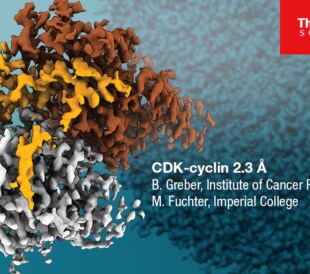National cryo-EM facilities democratize cryo-electron microscopy
Cryo-electron microscopy (cryo-EM) is revolutionizing structural biology, bringing new insights, and bridging observations made by other structural analysis techniques. A number of shared facilities and national centers around the world are providing cryo-EM education, often at little to no cost, thus driving the adoption of this powerful technique. Additionally, cryo-EM instrumentation is constantly improving, meaning that even lower-kV cryo-electron microscopes are now capable of generating valuable structural insights.
Cryo-EM at the New York Structural Biology Center
One of the facilities seeking to broaden access to cryo-EM is the New York Structural Biology Center (NYSBC), a non-profit facility in New York City which provides its members access to advanced structural biology resources, including cryo-EM instruments and training. It’s also part of a system of National Cryo-EM Centers, supported by the NIH Common Fund. We spoke with Edward Eng, Ph.D., Senior Scientist and Manager at the NYSBC about their efforts to increase cryo-EM access and create a sustainable cryo-EM ecosystem.
“A key part of what we do here is educational outreach. The reason for that is because cryo-EM is an emerging technology. It hasn’t really stabilized. Every year, we keep on growing and developing new tools and we go to different fields,” said Eng. “The best way to create a sustainable ecosystem is to create cryo-EM champions, and that’s why we’re not just focusing on current scientists, but also scientists early in their careers who are interested in using cryo-EM as a technology.”

Edward Eng at the New York Structural Biology Center
The Cryo-EM Merit Badge
One way the New York Structural Biology Center is promoting cryo-EM education is through the Cryo-EM Merit Badge Program, which is provided across all U.S. National Centers for Cryo-EM. This program offers a standardized set of training that ensures badge recipients are well versed in the core fundamentals of cryo-EM, from sample preparation to data processing. Badges are honored across all national centers and reduce the need for duplicate training.
As Eng notes; “The Cryo-EM Merit Badge program is a proficiency program. It allows the centers to cross-train and cross-certify users. We’ve noticed that many researchers, once trained at a national center, want to go home with protocols and best practices, and the Merit Badge Program provides that framework for them.” This program also offers Merit Badges for select cryo-EM tools, and Eng shared that a Merit Badge for the operation of the Tundra Cryo-TEM is in progress.
Increasing demand for more accessible cryo-EM instrumentation
With the growing popularity of cryo-EM, research institutions may have questions regarding resources and physical space needed to support the technique. Eng notes how the Thermo Scientific Tundra Cryo-TEM specifically has appeared as an attractive option for many of these institutions.
“One of the reasons why we are really excited about [the Tundra Cryo-TEM] is that it is helping democratize cryo-EM… It has a lot of functionality, and we foresee a lot of low-resource institutions coming in and making use of that form factor. It has been one of the most highly utilized training tools that we have at our center.” Regarding the introduction of a new detector option and its impact, Eng noted “The availability of the Falcon C [detector] for the Tundra Cryo-TEM will be game changing. So not only [can] the Tundra [Cryo-TEM be used] as a screening microscope, but [as] a data collection tool. And that versatility is great for institutions that may only have one TEM.”

Thermo Scientific Tundra Cryo-TEM
Training the next generation of cryo-EM experts at the New York Structural Biology Center
Fundamentally, it’s clear that the future of cryo-EM depends on the community that is forming around this technique. It will rely not only on the current generation of cryo-EM experts, but also new researchers and students who are just becoming familiar with the technique.
“I think that’s very important, not just in terms of outreach in other fields and getting people interested in cryo-EM, but we have to create that ecosystem,” Eng notes. “Our future operators, our future directors, our future scientists will be our former trainees and users. If we don’t do a great job training them now, then I don’t know how sustainable and scalable we will be.”
National centers, such as the New York Structural Biology Center, are creating a vital foundation on which this technique, and its capabilities, can flourish.
Eng noted that cryo-EM is a great field for young scientists and advised that they not be afraid to jump in, even as the technology continues to evolve. ““There’s a lot of support. The National Center Program is here and will be here for a long time.”





Leave a Reply